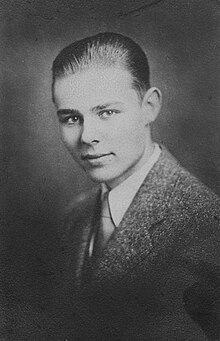Worth Hamilton Weller (May 28, 1913 – June 22, 1931) was an American herpetologist who discovered two new salamanders, Gyrinophilus porphyriticus duryi [1] and Weller's salamander (Plethodon welleri).[2]

Weller died in a fall from a cliff at Grandfather Mountain near Linville, North Carolina.
Early life edit
Weller was born in Cincinnati, Ohio. His parents were Arthur Douglas Weller and Ruth Hamilton Weller.[citation needed]
Herpetology edit
His interest in herpetology, specializing in salamanders, developed when he was a young boy. He explored nearby fields and woods with his friend Karl Maslowski (1913-2006), who went on to become a well known wildlife photographer.[3][4] Soon Weller was recording observations for the Cincinnati Museum of Natural History. Shortly after the director of the museum, Ralph E Dury (1899-?) established the Cincinnati Junior Society of Natural Sciences, Weller joined in 1928 and at the age of sixteen, became its business manager and Curator of Herpetology.[5]
Weller carried out an extensive correspondence with the herpetologist Emmett Reid Dunn which led to his acceptance at Haverford College. Between 1930 and 1932 he published 12 papers, most of which were reprinted in 1965.[2]
Specimens edit
In April 1930 he visited Cascade Caverns in Kentucky with Dury where he collected the type specimen of a salamander he described and named after Dury, Gyrinophilus porphyriticus duryi (Weller, 1930).[1] During the summer vacation between his sophomore and junior years at Walnut Hills High School he visited Grandfather Mountain in North Carolina with Dury, where he discovered the first specimens of Weller's salamander (Plethodon welleri).[2]
Death edit
A week after Weller graduated with high honors from high school, Dury took members of the Junior Society to Grandfather Mountain to find more specimens for Weller. The afternoon they arrived, Weller left the others to go collecting, despite the bad weather, and never returned. Four days later his body was found wedged between boulders in a creek below the mountain. Weller was discovered with a collecting bag which contained specimens of his new species.[2]
References edit
- ^ a b Burt, Charles E. 1933. "A Contribution to the Herpetology of Kentucky". American Midland Naturalist 14 (6): 669-679.
- ^ a b c d Adler, Kraig (2007). Contributions to the History of Herpetology, Volume 2. Society for the Study of Amphibians and Reptiles. p. 182. ISBN 978-0916984717.
- ^ "Wildlife Photographer: The Life of Karl Maslowski – Home". June 10, 2019.
- ^ http://www.cnah.org/news.asp?id=280 Archived 2011-05-18 at the Wayback Machine In Memoriam: Karl Maslowski The Center for North American Herpetology
- ^ "Proceedings of the Cincinnati Society of Natural Sciences, v.2-3 1931-1932, [1] Archived 2019-12-22 at the Wayback Machine
External links edit
Further reading edit
- Adler, Kraig. 2007. Contributions to the History of Herpetology, Volume 2. Society for the Study of Amphibians and Reptiles. 400 pp. ISBN 978-0916984717.
- Sasse, D. Blake. 2003. "Job-Related Mortality of Wildlife Workers in the United States, 1937-2000". Wildlife Society Bulletin 31 (4): [2].
- Tager, Mike. 1999. Grandfather Mountain: A Profile. Parkway Publishers. ISBN 978-1-887905-17-6.
Publications by W.H. Weller edit
- Walker, Charles F., and Weller, W. Hamilton. 1932. "The Identity and Status of Pseudotriton duryi ". Copeia 1932 (2): 81–83. (Published by the American Society of Ichthyologists and Herpetologists).
- Weller, W.H. 1930. "Notes on amphibians collected in Carter Co., Kentucky." Proceedings of the Junior Society of Natural Sciences, Cincinnati 1 (5/6): 6–9. (counted).
- Weller, W.H. 1930. "On a recent occurrence of the blue-tailed skink in Hamilton County (Ohio)". Proc. Jun. Soc. Nat. Sci., Cincinnati 1 (5/6): [page numbers needed].
- Weller, W.H. 1930. "Notes on Aneides aeneus (Cope and Packard)." Proc. Jun. Soc. Nat. Sci., Cincinnati 1 (2): [?-?].
- Weller, W.H. 1930. "A preliminary list of the salamanders of the Great Smoky Mountains of North Carolina and Tennessee." Proc. Jun. Soc. Nat. Sci., Cincinnati 1 (2): [?-?].